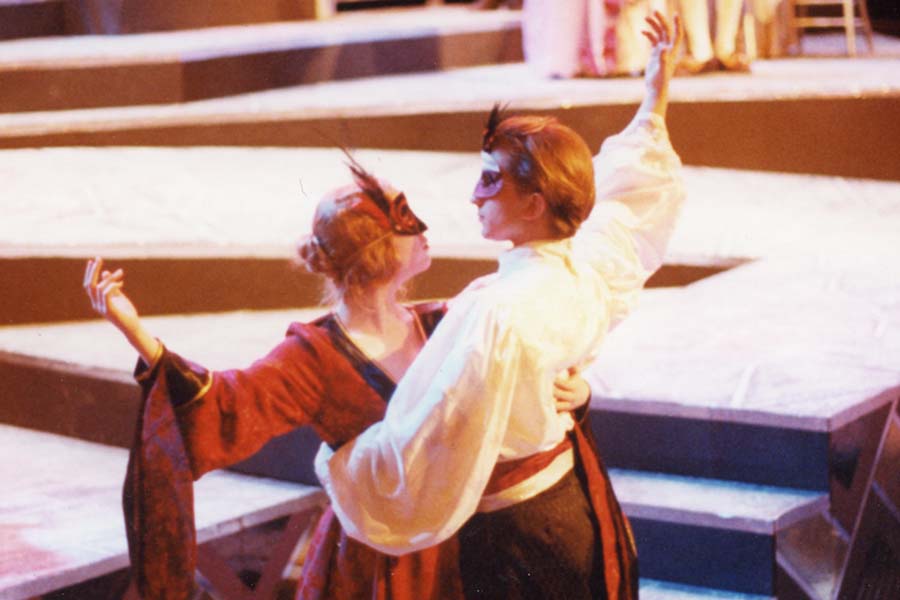
In 1971, the notion of whisking a cohort of Knox College students away to a farm in Wisconsin for a 10-week, 3-credit academic course called Farm Term was unheard of. Fast forward more than five decades and this innovative concept has become a cornerstone of Knox College’s curriculum.
Immersive terms at Knox are now a regular part of the student experience, like study abroad or First-Year Preceptorial, and prospective students actively seek out Knox because of these transformative opportunities. To understand how this concept came to fruition, one must take a step back even further in time than Farm Term.
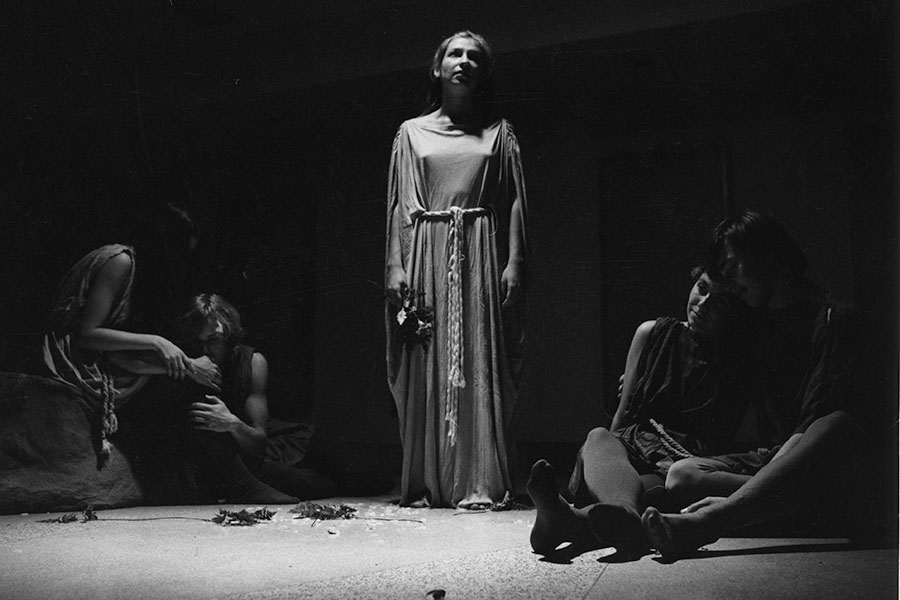
The genesis of modern immersive terms at Knox can be traced back to the Repertory (Rep) Term, first documented in the 1969-1970 course catalog. At the time led by Robert “Doc Bob” Whitlatch and Ivan “Mr. D” Davidson, Rep Term endures to this day with its 20th iteration slated for winter 2025. The pair began the development of Rep Term in 1967, hoping to create something new within the department that challenged students as actors and within the technical side of live performance.
The term was founded as an exploration of various elements of theatre, including acting, technical production work, management, producing, student designing, and classroom study to foster a professional environment for students. This unique experience was a major draw for students pursuing a theatre career or those interested in simply immersing themselves in the field.
Smith V. Brand Distinguished Professor of Theatre Liz Carlin Metz today collaborates with colleagues Associate Professor of Theatre Craig Choma ’93, Associate Professor of Theatre Jeff Grace, Assistant Professor of Theatre Deana Nichols, and Instructor and Costume Studio Supervisor Allison Hahn to deeply engage students in the creative process and decision making by simultaneously
producing two live shows.
Over time, Rep Term has undergone key curricular changes. Originally envisioned as a conservatory style experience when the American repertory theatre system was still prolific, it was adapted to better suit the needs of students in a modern academic environment and prepare them for the kinds of early career theatre experiences more reflective of the modern theatre industry. The intense workload, reminiscent of the kind of workday professional theatre makers undertake, proved unsustainable, leading to a shift in approach catering to individual skill development and retaining core Rep Term concepts.
“
“I appreciate everything that I eat so much more. I have tried to produce more of my food, too. All my children have gardens. Some have chicken and bees; the Farm Term extends through generations. I have taken my children and now my grandchildren to working family farms so they can gather eggs, feed animals, and shovel manure. I want them to see the whole process just like I did.”
—Jan Dressel ’71, Farm Term
It wasn’t long until additional immersive concepts entered Knox’s curriculum. During the spring term of 1971, George A. Lawrence Distinguished Service Professor Emeritus and co-director of the Lincoln Studies Center Doug Wilson helped lead the charge for Farm Term to take root.
Having just purchased land in Crawford County, WI, with wife Sharon, his colleagues Dewey Moore, geology, and Robin Metz, English and Creative Writing, joined in, purchasing property of their own near the Wilsons’ farm.
In that era, Wilson recalls a desire for curricular innovation. The term was classified under a new concept called a “satellite curriculum,” a precursor to the immersive experiences that Knox continues to this day. The curriculum committee accepted the idea, and nearly 30 students signed up to take part.
“The ideas of what teaching could be were evolving,” Wilson said. “There was a lot of new blood mixed in with the old faculty. We had new ideas and wanted to work together to improve what Knox could offer.”
The concept of Farm Term was wholly original and widely examined. Wilson recalls many colleagues within Knox and in neighboring institutions questioning whether or not this term could truly be considered a college course. Could raising chickens and growing vegetables replace textbooks and chalkboards? The term even attracted the attention of the Chicago Tribune, landing a front-page article highlighting the radical new concept of learning happening at Knox.
Similarly groundbreaking was the introduction of Open Studio during the 1970-71 academic year, a hallmark of the studio art major. Now in its fifth decade, Open Studio remains the ultimate test of artistic readiness, challenging students to pursue creative expression with minimal guidance. During the winter term of their senior year, with no other courses, students immerse themselves in the studio with no guidelines. The goal is simply to create.
Though the core remains much the same, the term has seen changes since its earliest year, including frequent faculty critiques, the use of digital tools to document work, and the addition of a senior practicum course in the spring to help bridge the gap between Open Studio in the winter and graduation.
Professor of Art Mark Holmes says the course is the ultimate test for students wanting to join the field. Even though the intensity of the course is clear, he says many prospective students come to Knox anticipating the challenge and looking forward to meeting it head-on.
“By the time Open Studio begins, we have to let go and see if the students have learned enough to hold on to on their own. It’s sink or swim,” Holmes said.
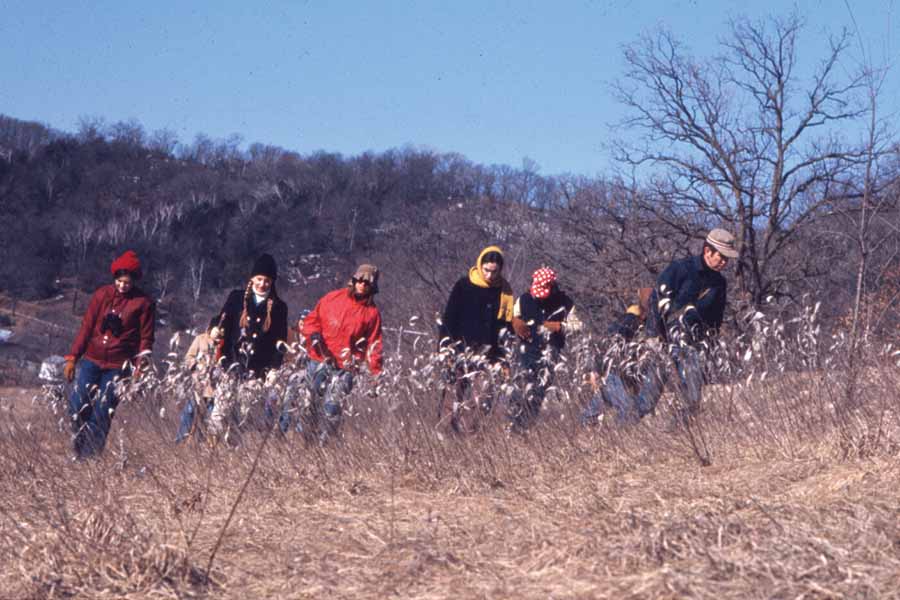
Farm Term only took place once, while Open Studio remains a core component of the art major. However, Farm Term wasn’t the only course concept that Wilson helped pioneer. Alongside Szold Distinguished Service Professor Emeritus of History Rodney Davis, Wilson helped develop the Great River course.
The course centered around the study of the Mississippi River. Students were introduced to the course by studying the river's history while on campus. Throughout the term, Wilson took students on short trips on the river and to towns developed along the river to study their history and to learn about how it was mapped over time.
Though it wasn’t designated as such at the time, one could argue that the Great River course was the precursor to what became known as short-term immersive opportunities.
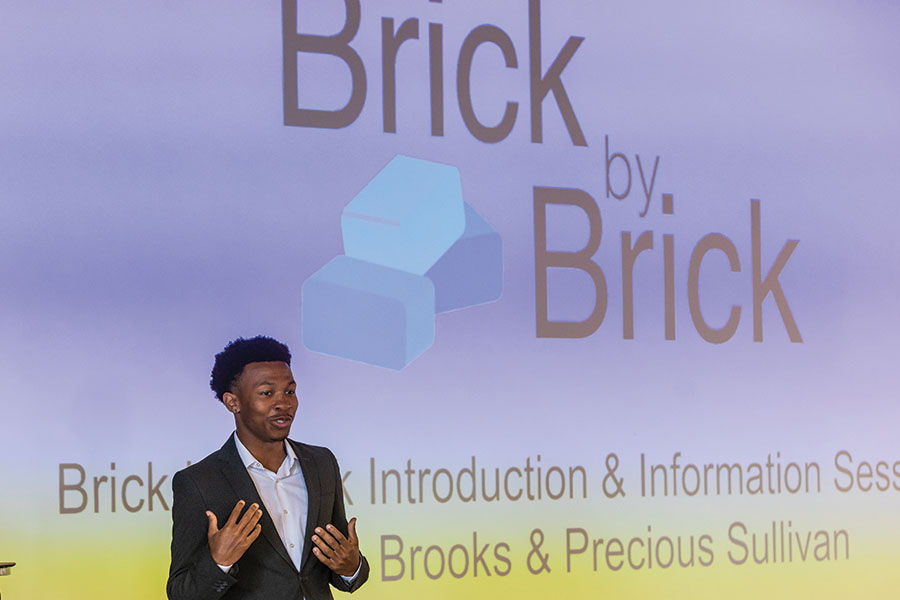
The Modern Immersive Term
Over the ensuing decades, immersive terms at Knox have continued to evolve and diversify.
In 2001-02, Green Oaks Term was introduced, adding a brand new experience to the slate of offerings. Much like a local study abroad option, Green Oaks Term sees students and multiple faculty members travel to the Green Oaks Biological Field Station outside of Victoria, IL, where they live as a small community. Although the term consists of classes, papers, assignments, and presentations, much of the learning takes place through immersion in the land during hikes in the woods, service projects, and more.
Watson Bartlett Professor of Biology and Conservation, Stuart Allison, who also serves as the director of the Green Oaks Biological Field Station, says the framework for the term was inspired by Farm Term. Allison worked alongside Professor Emeritus of Anthropology Jon Wagner and Robin Metz to create Green Oaks Term, with a desire to better utilize the space.
The founding years of the term focused on teaching students the biological, artistic, and anthropological elements of Green Oaks, looking at plants, animals, and signs of human life in the area before development. Metz developed the natural imagination course element of the term, which focused mostly on creative writing, thought did include some visual art. Over the last two decades, many faculty members have joined the course in various ways, including Associate Professor of Art Tony Gant.
“
Michael DeGroot’s ’03 internship at Cottonwood Healthcare Center in Galesburg, a residential treatment facility for individuals with serious mental illness, led to his first job as a psychosocial rehabilitation services coordinator. This experience paved the way for medical school and a psychiatry residency at the University of California, San Diego. Michael now works as an inpatient attending psychiatrist at VA Minneapolis and teaches medical students at the University of Minnesota Medical School.
Students were given the choice of what academic avenue they wanted to pursue. However, though the academic focus was individualized, the core concepts of living as a community in a remote biological field station have remained the same to this day.
“Setting up the community is a key feature,” Allison said. “You’re in this space with these people, and you have to make it work. Different people have different tolerances for noise, sloppiness, etc. At its core, though, this is an opportunity to be a part of something you’ll never be able to do again, with the structure of a college education around you.”
In the following academic year, 2002-03, another immersive term was introduced to the curriculum, Clinical Psychology Term (CPT). Founded by Emeritus Professor of Psychology Tim Kasser, the term helps students completely immerse themselves in clinical and counseling psychology by taking two clinically-focused course, while also completing a clinical psychology internship.
CPT gives students local opportunities to learn, through partnerships with centers such as the Safe Harbor Family Crisis Center, Galesburg Rescue Mission, assisted living facility Seminary Manor, and more. Kasser says CPT was designed not only to teach but to gauge whether or not students would still be interested in the field after experiencing it first-hand.
“It’s a powerful way of learning to see that,” Kasser said. “It’s nice to put students into the environment where it actually happens. There can be a skewed image of what mental health services really look like.”
CPT has a unique structure among immersive terms, giving students a classroom learning experience in parallel to the in-person internship work, which takes place within the same course week instead of being separate parts of the term. Because of this, Robert M. & Katherine Arnold Seeley Distinguished Professor and Chair of Psychology Heather Hoffman says students internalize coursework more directly. “Our community partners offer a stable environment for students to learn different elements of the field,” Hoffman said.
Entering the 2003-04 academic year, a change was made in the course catalog to help differentiate immersive offerings. A new section titled Special Programs and Opportunities was created, creating a defined space for study abroad, independent studies, and courses that would today be considered immersive terms.
Among the newest immersive concepts, StartUp Term was pitched and landed on the curriculum 2015-16. Again, providing a new concept of what an immersive term could be, StartUp Term invites teams of Knox entrepreneurs to transform original business concepts into real services and products.
Associate Professor of Computer Science Jaime Spacco says the term was hatched out of a conversation between himself, William & Marilyn Ingersoll Professor Emeritus of Computer Science John Dooley, and Wagner Distinguished Chair Emeritus in Business and Executive-in-Residence John Spittell. The group wanted to create a course that merged business concepts with elements of computer science. After going back to the drawing board multiple times, StartUp Term was eventually created.
Spacco says the course is a natural progression of the liberal arts approach, giving students with grand ideas a format to realize them. Student pitches are funneled in fall term and, if accepted, put into the 10-week entrepreneurship gauntlet in the spring. Spacco believes this course is another way Knox provides various educational approaches.
“Students may have an idea of what they want to do, they may have this really great idea, and this term allows them to put those ideas to the test while giving them a soft landing if it doesn’t work out,” Spacco said.
Associate Professor of Art Tim Stedman ’09 joined the course faculty list in 2017, bringing a design mindset to the table and helping students clarify the identity of their project through visual elements. “I wanted to help students conceptualize the face of their project and focus on the identity of their pitch,” he said.
Now, four iterations of the term later, student pitches have gone all the way to sessions of Elmspring. This real estate accelerator supports technology startups, including the “Chart Air” concept in 2017. This pitch aimed to make flight planning easier and more efficient through an online platform that provided data for airport fees for private airplane flights.
As of 2024, these five courses (Rep Term, Green Oaks Term, CPT, Open Studio, StartUp Term) remain core offerings. There are also short-term immersive experiences, which offer another format for experiencing the immersive experience, including Knox in New York, London Arts Alive, or Teaching on the Navajo Reservation.
More recently, following education interruptions from the COVID pandemic, Immersion Summer courses were designed to provide immersive experiences without the barrier of travel. The coursework was divided into 4- and 6-week courses, ranging from studies utilizing the Knox Observatory, to a course on Middle Eastern music with trips to Chicago and Michigan.
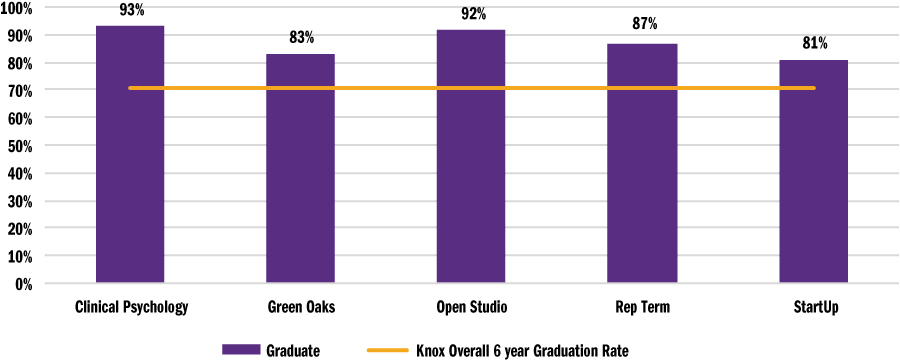
Common Threads
Looking at immersive terms from a wide angle, it becomes clear that these courses have connecting threads making them uniquely Knox. One such thread is the approach to providing a deep, focused view of the concept.
During a regular term at Knox, many students will shuffle three courses, on top of extra-curricular activities and even a job on or off campus. Immersive terms at Knox provide a moment for students to shut off the need for multitasking and soak in a deep well of knowledge in a singular area of study.
Having taken part in more than half of the total Rep Term courses since 1970, as a student and as a professor, Choma says Knox students have always looked for a way to create their academic pathways. Over the years, Choma says Rep Term has had to adjust its approach to providing the theatre experience, limit what is mandatory within the term, and bolster the individual outcomes and goals. By allowing students to focus solely on lighting or solely on costuming instead of forcing them to act on stage (which at one time was a requirement), students can slow down and focus deeply.
“Immersive learning slows down and quiets the noise,” Choma said. “Students are accustomed to multi-tasking, multi-screening their lives. But when they do that, the information is much more surface-level. Having a deeper understanding of a singular concept is key.”
Spacco sees StartUp Term in a similar light, allowing students to collaborate on a single pitch and work on every facet. From crafting an idea to testing its viability and designing every element to the literal office spaces rented in Galesburg for students to work from, StartUp Term is designed to truly recreate the entrepreneurial process. He sees this approach as a defining factor of what makes immersive terms special at Knox, providing a modern approach to teaching that is an evolution of the core concepts.
“Education is different for everyone,” Spacco said. “Immersive terms take the preconceived idea of what school is and inject some modern sensibilities.”
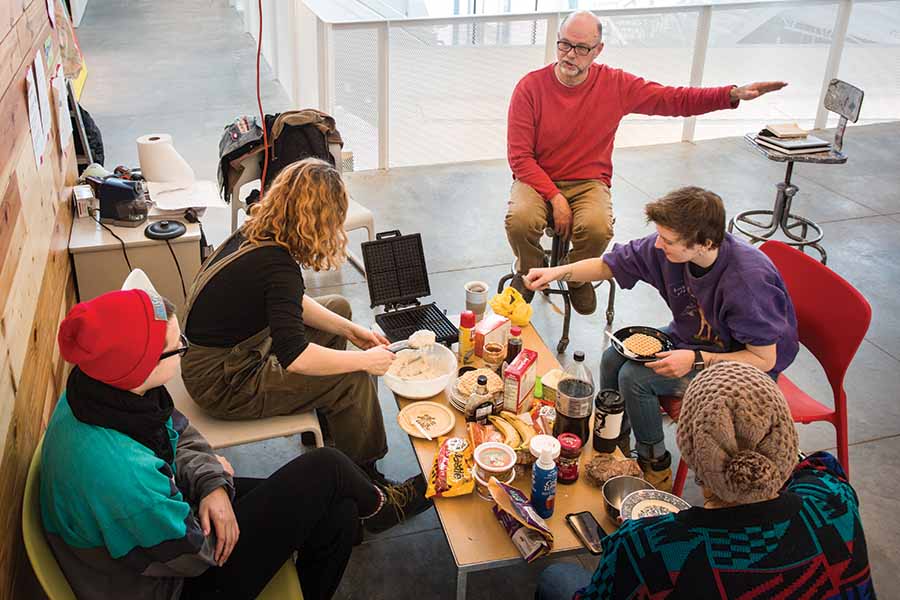
Another connecting thread is the idea that immersive terms provide a simulation of real-world opportunities. From the artistic freedom of working in a studio with no guidance on your next project, to the in-person internship experiences of working as a clinical psychologist, immersive terms give students the framework to live out the experiences for these fields, while developing skills in a controlled environment.
Looking back at the original immersive concepts, Wilson says Farm Term’s student body included many students from metropolitan areas. The term allowed the faculty members involved to give these students a one-to-one simulation of life on the land in 1971, something that could never be accomplished in a classroom setting. This has remained a core draw for many prospective and current students when considering immersive terms, something for which Knox Provost and Dean of the College Michael Schneider believes the
College has been a trailblazer.
“Nationwide, we were certainly ahead of most places when the idea of immersive terms was created. We were a leader and innovator in this idea,” Schneider said.
“
“StartUp Term had a huge impact on me during my time at Knox and still is to this day. It allowed me a chance to help lay the foundation for my creativity, teamwork, and entrepreneurship skills. Working on a team and with professors with different skills showed me the importance of always combining different minds and continuously learning from the people around you whether you're trying to make a profit or not.”
—Cortney Hill ’17 StartUp Term
The Perfect Trimester Fit
Few elements of the immersive term structure are as representative of the Knox educational structure as the way these terms fit into the trimester curriculum.
By utilizing the 10-week structure of trimesters, students can try immersive terms without interfering with a significant amount of their overall education. When developing CPT, Kasser says these terms “fit brilliantly” into the trimester framework. If a student wants to try out a term and, in the case of CPT, ends up disliking the fundamentals of what they experience, a single trimester spent experimenting is less disruptive to their time at Knox.
Many faculty involved with teaching immersive courses agree that the workload necessary to complete a common immersive term would be equivalent to two typical semesters. When looking at it from this perspective, a single trimester term is 1/12 of a total Knox education, whereas the necessary two semesters of work would be the equivalent of 1/8.
Short-term immersive courses such as Knox in New York also thrive in the trimester curriculum, utilizing the winter break as an opportunity to complete the fall trimester studies with a travel experience that doesn’t interrupt the normal course load.
This does not mean that immersive terms are any less impactful at only 10 weeks. For Green Oaks Term, Allison says this 10-week window provides a timeframe to remove students from their normal campus environment long enough to immerse themselves in the area and form a new community without disconnecting them from the greater Knox community for too long.
Ultimately, the trimester system is a fundamental element of immersive terms at Knox, allowing students to take risks and experiment with their education.
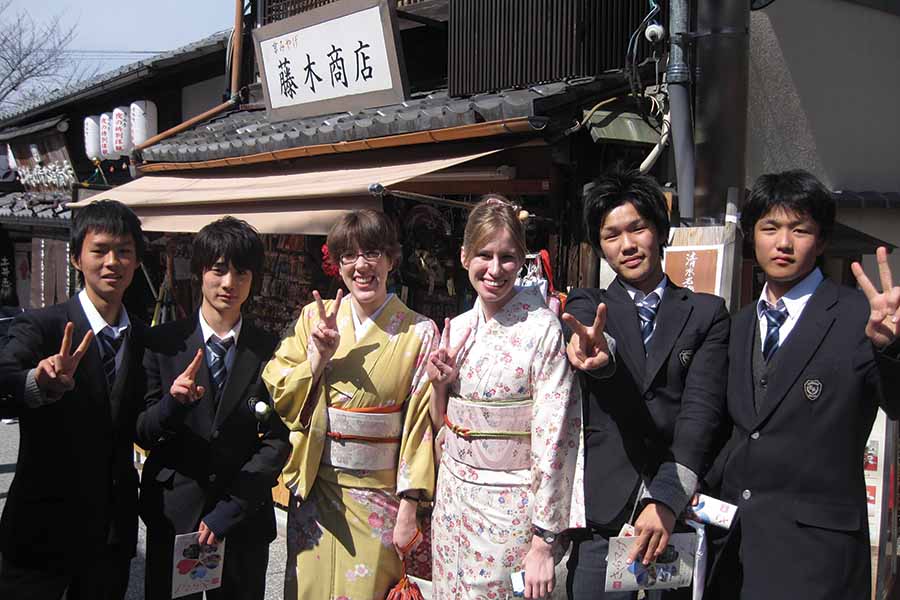
The Future of Immersive Learning
As Knox moves forward and curriculums continue to evolve, one might naturally question where immersive terms will go from here. An immersive and active learning element was added to graduation requirements for students in 2018, emphasizing immersive terms as a key part of a Knox experience. In the immediate future, Schneider provided some insight into terms returning in the next few academic years.
Assistant Professor of History Jessa Dahl ’10 will help lead the return of Japan Term, an immersive term that debuted in 2006 with additional opportunities in 2008, 2010, and 2014. Formerly led by Schneider and R. Lance Factor Endowed Professor in Philosophy Bill Young, Schneider believes that Dahl will be the first immersive term leader to both join the term as a student and now teach it herself.
“
After graduating cum laude in history and with a passion for theatre, Amy Carlson ’90 began her acting career starring on the soap opera Another World from 1993 to 1998. This role launched her into movies and as a series regular on television programs, including Third Watch and Blue Bloods. Early in her career, Amy was heavily involved in Chicago’s small theatre scene, where she gained a diverse skill set in costume design and production. She believes her Rep Term experience gave her a greater grasp of what it takes to put on a show and made her more valuable to theatre companies. She emphasizes the importance of staying curious and open to learning, as theatre is a fast-moving industry that requires constant adaptation.
Japan Term sees students study three separate Japan-centric courses on philosophy, language, and history. After immersing themselves in the coursework, students board a plane and travel to Japan for multiple weeks, taking the knowledge they learned in the classroom and transferring it to real-world locations, monuments, and social interactions.
Dahl says Japan Term is truly about immersing oneself in the culture of Japan, more than aiming at a future career or skill set attached to the course.
“We want students to enjoy Japan for Japan, not because there is a career attached,” she said.
Schneider also mentioned the possibility of other terms returning as well. These may include European Identities, offered in 2014 with a 17-day trip to Berlin and Istanbul in December built-in to enhance classroom studies, or Knox in Cuba, offered in 2017 and including an 11-day trip to Cuba, focusing on the country’s people and culture while taking classes in Cuban styles of dancing and drumming.
There is also a strong possibility that Knox will create new immersive offerings, with many being conceptualized each year. Schneider mentioned the idea of Galesburg Term, where students would learn to live within a city the size of Galesburg and embrace the community and economic offering, or even Nuclear Term, where students would study the imagery and media of nuclear culture while visiting historical sites in the U.S. and around the world related to the rise of the nuclear age.
“We want immersive terms to remain a totalizing experience. We don’t want to get away from that idea,” Schneider said.
Ultimately, the hardest question to answer is whether bolstering existing courses or simply adding more courses is the better overall direction for the future health and longevity of immersive terms as a whole. When confronted with this concept, Dahl shared a perspective somewhere in the middle.
To Dahl, the strength of immersive learning is in the interest shared by the faculty and students involved. Stedman shared a similar sentiment, sharing that perhaps the best road forward isn’t to choose either option but to continue the evolution of the concept as a whole and continue to make it a fundamental part of Knox.
“Immersive terms are influenced and improved by the students and faculty involved.
Their interest drives everything forward,” Stedman said. “We need to continue to adapt to what the students need, seeking their interests and providing them with something great.”